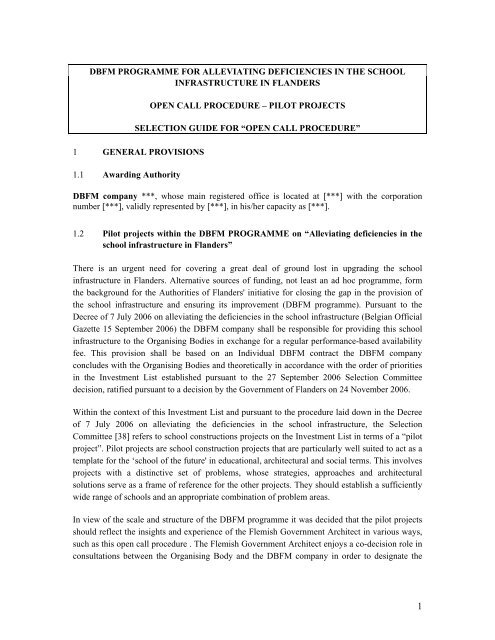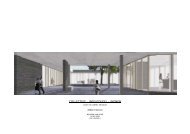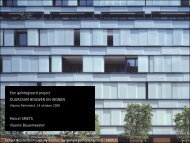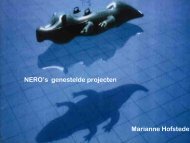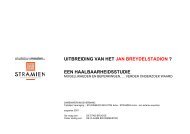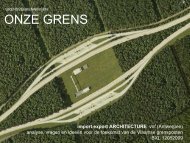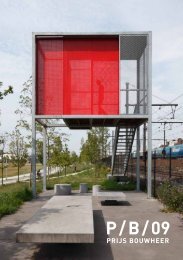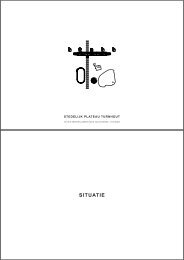here - Vlaams Bouwmeester
here - Vlaams Bouwmeester
here - Vlaams Bouwmeester
You also want an ePaper? Increase the reach of your titles
YUMPU automatically turns print PDFs into web optimized ePapers that Google loves.
DBFM PROGRAMME FOR ALLEVIATING DEFICIENCIES IN THE SCHOOL<br />
INFRASTRUCTURE IN FLANDERS<br />
OPEN CALL PROCEDURE – PILOT PROJECTS<br />
SELECTION GUIDE FOR “OPEN CALL PROCEDURE”<br />
1 GENERAL PROVISIONS<br />
1.1 Awarding Authority<br />
DBFM company ***, whose main registered office is located at [***] with the corporation<br />
number [***], validly represented by [***], in his/her capacity as [***].<br />
1.2 Pilot projects within the DBFM PROGRAMME on “Alleviating deficiencies in the<br />
school infrastructure in Flanders”<br />
T<strong>here</strong> is an urgent need for covering a great deal of ground lost in upgrading the school<br />
infrastructure in Flanders. Alternative sources of funding, not least an ad hoc programme, form<br />
the background for the Authorities of Flanders' initiative for closing the gap in the provision of<br />
the school infrastructure and ensuring its improvement (DBFM programme). Pursuant to the<br />
Decree of 7 July 2006 on alleviating the deficiencies in the school infrastructure (Belgian Official<br />
Gazette 15 September 2006) the DBFM company shall be responsible for providing this school<br />
infrastructure to the Organising Bodies in exchange for a regular performance-based availability<br />
fee. This provision shall be based on an Individual DBFM contract the DBFM company<br />
concludes with the Organising Bodies and theoretically in accordance with the order of priorities<br />
in the Investment List established pursuant to the 27 September 2006 Selection Committee<br />
decision, ratified pursuant to a decision by the Government of Flanders on 24 November 2006.<br />
Within the context of this Investment List and pursuant to the procedure laid down in the Decree<br />
of 7 July 2006 on alleviating the deficiencies in the school infrastructure, the Selection<br />
Committee [38] refers to school constructions projects on the Investment List in terms of a “pilot<br />
project”. Pilot projects are school construction projects that are particularly well suited to act as a<br />
template for the ‘school of the future' in educational, architectural and social terms. This involves<br />
projects with a distinctive set of problems, whose strategies, approaches and architectural<br />
solutions serve as a frame of reference for the other projects. They should establish a sufficiently<br />
wide range of schools and an appropriate combination of problem areas.<br />
In view of the scale and structure of the DBFM programme it was decided that the pilot projects<br />
should reflect the insights and experience of the Flemish Government Architect in various ways,<br />
such as this open call procedure . The Flemish Government Architect enjoys a co-decision role in<br />
consultations between the Organising Body and the DBFM company in order to designate the<br />
1
successful candidates who are then taken into account for participating in the award of the<br />
contract to design the school construction projects referred to as pilot projects.<br />
The procedures according to which (i) successful candidates are identified and (ii) are then<br />
invited to participate in the following negotiating process for awarding the design contract form<br />
part of this award process (open call procedure ).<br />
1.3 Brief description of the contract<br />
The purpose of this open call procedure is to designate a designer for each pilot project who shall<br />
be responsible for producing a preliminary design for the relevant pilot project under the DBFM<br />
programme “Alleviating deficiencies in the school infrastructure in Flanders”<br />
The pilot projects are listed and briefly described as annex 2, to this selection guide. For those<br />
interested in presenting a request to participate, the awarding authority has produced an<br />
information booklet clarifying the various pilot projects. This booklet may be requested free of<br />
charge at the following URL: www.vlaamsbouwmeester.be<br />
1.4 Award procedure<br />
The designation of the successful candidates is legally based on the design competition (art. 20<br />
and 21 of the Law of 24 December 1993 read in conjunction with art. 75 up to 77 of the Royal<br />
Decree of 8 January 1996).<br />
The subsequent award of the design contract, for producing a preliminary design for the relevant<br />
pilot project, to one of the successful candidates shall be based on a negotiating process without<br />
prior notice (art. 17, §2, 4° of the Law of 24 December 1993).<br />
This open call procedure is t<strong>here</strong>fore based on a multiphase process.<br />
Phase 1: Selection of candidates invited to provide a preliminary design<br />
The first phase of the open call procedure covers the selection of the candidates : the<br />
admissibility, reliability and aptitude of the candidates are investigated in the light of the criteria<br />
referred to in this selection guide .<br />
Two-stage selection process.<br />
Against the background of a preliminary selection, the Flemish Government Architect draws up a<br />
shortlist with a maximum of 10 valid candidates who meet the minimum conditions and formal<br />
requirements. Mindful of the Flemish Government Architect's co-decision role this phase is<br />
organised subject to the responsibility and accountability of the Flemish Government Architect.<br />
2
The Selection Committee then chooses a maximum of three candidates per pilot project from the<br />
aforementioned shortlist (provided t<strong>here</strong> is a sufficient number of competent candidates featured<br />
on the shortlist drawn up by the Flemish Government Architect). Should the number of suitable<br />
candidates exceed the maximum number of three, the Selection Committee shall reduce the<br />
number of candidates to the maximum, in the light of the selection criteria referred to in point 2.4.<br />
Fase2: Choice of successful candidates in the context of the design competition<br />
The selected candidates shall be issued with an award guide w<strong>here</strong> the follow-up of the open call<br />
procedure shall be described in detail.<br />
In the second phase of the open call procedure the selected candidates shall be invited to submit a<br />
preliminary design. Based on the design competition this phase culminates in the designation of<br />
the successful candidates.<br />
Phase 3: Awarding the services contract to one of the successful candidates as a result of a<br />
negotiating process without prior notice<br />
The design contract is awarded according to a negotiating process without prior notice. All<br />
successful candidates normally take part in this negotiating process. The contract is concluded<br />
according to a model agreement for the implementation of the design contract.<br />
2 SELECTION PROCEDURE<br />
2.1 What the selection procedure involves<br />
(a)<br />
Preliminary selection by the Flemish Government Architect<br />
The first assessment of the requests to participate which are consistent with the exclusion clauses<br />
and admissibility conditions forms the background for the Flemish Government Architect<br />
drawing up a shortlist of a maximum of 10 candidates. At this stage of the procedure, requests to<br />
participate shall be assessed according to the same criteria described in point 2.4. The Flemish<br />
Government Architect's co-decision role is such that the latter shall be responsible and liable for<br />
organising this phase.<br />
(b)<br />
Further selection by the Selection Committee<br />
The second part of the selection phase is designed to allow the Selection Committee to pick a<br />
maximum of three candidates per pilot project from the shortlist (provided t<strong>here</strong> is a sufficient<br />
number of competent candidates featured on the shortlist drawn up by the Flemish Government<br />
Architect ) and after the selection process these shall be able to present a preliminary design for<br />
the relevant pilot project.<br />
3
The Selection Committee comprises the following members entitled to vote:<br />
- the Flemish Government Architect (president);<br />
- an AGIOn (Flemish Agency for Infrastructure in Education) project leader;<br />
- two representatives of the DBFM company ;<br />
- two representatives of the relevant schools groups (s) (a schools group is a voluntary cooperation<br />
arrangement between primary and secondary educational institutions of the<br />
Community Education) and/or managements.<br />
The Selection Committee's advisory opinions are issued on a collective basis. Each member has<br />
one vote.<br />
The Selection Committee's secretary is responsible for drawing up the selection report but is not<br />
entitled to vote.<br />
Should the number of suitable candidates exceed the maximum number (three) the Selection<br />
Committee shall reduce the number of candidates to the maximum in the light of the selection<br />
criteria referred to in point 2.4. (b).<br />
The selection criteria listed below are used by the Selection Committee as a basis for providing a<br />
reasoned and binding selection proposal to the awarding authority.<br />
2.2 Exclusion grounds<br />
Any candidates to whom one of the exclusion cases provided for in art. 69 of the Royal Decree of<br />
8 January 1996 applies may be prevented from taking part in this open call procedure.<br />
When making an application the candidates are required to expressly declare that their situation is<br />
not such as to bar them from participating in public contracts and they meet the requirements laid<br />
down in art. 69a of the Royal Decree of 8 January 1996.<br />
The candidates are required – on pain of exclusion – to answer all the questions or to provide any<br />
information and documents the awarding authority may request so as to check the candidate is not<br />
in a situation of being excluded.<br />
2.3 Admissibility conditions<br />
Access to the open call procedure is dependent on being featured on the association of architects<br />
list or the list of trainees (or a similar professional association in the European Union). Foreign<br />
architects have to meet the requirements of the laws of their countries for pursuing the profession<br />
of architect.<br />
4
2.4 Qualitative selection criteria<br />
(a)<br />
Financial and economic capacity<br />
The candidates have to show they have a sufficient financial and economic capacity to fulfil the<br />
contract and to do so by offering evidence that they are insured against professional liability, with<br />
an appropriate level of basic coverage for the projects the candidates choose.<br />
(b)<br />
Technical aptitude<br />
The candidates have to show they have the right technical aptitude to fulfil the contract and to do<br />
so by presenting the following documents and references:<br />
- A description of the “office”: a statement about the in-house organisation, the composition of<br />
the office, the technical equipment and facilities the service providers have for the provision of<br />
services. The description also features (i) a description / assessment of the availability of the team<br />
given the scale and number of pilot projects for which the candidate has presented a request to<br />
participate and (ii) a list of the declarations of intent about the partnerships the candidate intends<br />
to enter into for the fulfilment of the contract.<br />
- Portfolio of designs and achievements: a brief presentation, with text, photographs and/or<br />
drawings, to specify what designs and projects the candidate has already completed. Against the<br />
background of each pilot project a reference is made in the portfolio – under pain of irregularity –<br />
to the specific maximum of three projects, similar or otherwise, in a personal capacity, allowing<br />
the conceptual capacity to be assessed in the light of the pilot project registered for.<br />
In the portfolio t<strong>here</strong> is a clarification for each project referred to: the customer, short description<br />
of the service, the cost price of the services and the (estimated) cost price of the completed<br />
project. If several pilot projects are being applied for under this call, the references should spell<br />
out for which pilot project they are being submitted, with due regard to the aforementioned<br />
maximum of three projects per pilot project.<br />
Without detracting from the aforementioned maximum-related obligation and the specification<br />
that has to be provided for each reference, the candidate's application form may refer to the<br />
presentation brochures for the candidate's office and monographs of the candidate's work<br />
available to the Flemish Government Architect pursuant to a recent application for the open call.<br />
The aforementioned documents should make it possible to build a picture of the vision, approach<br />
and quality of the candidate's achievements and more particularly :<br />
1. the general design-driven expertise in the light of the project assignment;<br />
2. the general analytical and conceptual capacities in landscape, urban development and,<br />
architectural terms and in terms of sustainability;<br />
5
3. the specific project-oriented team expertise;<br />
4. team composition, professional competence and relevant experience.<br />
3 REQUEST TO PARTICIPATE<br />
3.1 Time limit and procedure for submitting the request to participate<br />
The candidates have to submit a request to participate (in duplicate and suitably bound)<br />
comprising :<br />
- the participation form with a declaration on honour about the grounds for exclusion and<br />
admissibility conditions, duly completed and signed by the competent person or persons;<br />
- documents about the qualitative selection criteria.<br />
The candidates' requests to participate must express their intention to enter into partnerships (for<br />
example, with other designers and/or design offices). In the application it suffices to mention the<br />
intention to enter into a partnership and the task of the partners.<br />
Applications to participate should reach the services of the Flemish Government Architect, Graaf<br />
de Ferraris-gebouw, Koning Albert II-laan 20 bus 9, 1000 Brussels, on *** at *** am/pm in<br />
respect of ***. The applications to participate may be delivered against acknowledgement of<br />
receipt, or sent.<br />
The application is confined to projects the candidates choose from amongst the list of pilot<br />
projects.<br />
3.2 Errors and omissions<br />
Should a candidate notice any errors and/or omissions in this document and even if these errors<br />
and/or omissions should allow or not prevent the candidate from submitting a request to<br />
participate, the candidate needs to mention such errors and/or omissions (and at the latest 10 days<br />
before the date for submitting the requests to participate), voluntarily and in writing, at the<br />
contact address provided in the notice, so the awarding authority shall be able to take the<br />
appropriate action to correct this.<br />
3.3 Language<br />
The candidates shall use solely Dutch in their verbal and written contacts with the customer. In<br />
the event of documents available only in another language, the customer may require a sworn<br />
translation, w<strong>here</strong> appropriate.<br />
6
DBFM PROGRAMME FOR ALLEVIATING DEFICIENCIES IN THE SCHOOL<br />
INFRASTRUCTURE IN FLANDERS<br />
1 GENERAL PROVISIONS<br />
1.1 Introduction<br />
OPEN CALL PROCEDURE - PILOT PROJECTS<br />
AWARD GUIDE FOR “OPEN CALL PROCEDURE”<br />
This award guide offers a description of the procedure and the rules that apply for the period<br />
starting from the invitation to the selected candidates to the submission of the preliminary design in<br />
the context of the competition, the designation of the successful candidates, and the award of the<br />
design contract and the conclusion of a contract with a designer (in accordance with the model<br />
agreement for the fulfilment of the study contract).<br />
The awarding authority reserves the right, w<strong>here</strong> necessary or required, to amend, supplement or<br />
clarify this document. Any amendments, additions and/or clarifications are announced to the<br />
candidates on the basis of a registered letter (with acknowledgement of receipt) or via e-mail with<br />
confirmation of receipt by the candidates.<br />
1.2 Awarding Authority<br />
DBFM company ***, whose main registered office is located at [***] with the corporation number<br />
[***], validly represented by [***], in his/her capacity as [***].<br />
Information about this tender document is available from: ***.<br />
Any correspondence to the customer should be sent in written form by letter, fax or e-mail to the<br />
above address.<br />
1.3 Brief description of the contract<br />
The purpose of this open call procedure is to designate one or more successful candidates for each<br />
pilot project under the DBFM programme “Alleviating deficiencies in the school infrastructure in<br />
Flanders”, and in particular designating successful candidates for [further clarification of pilot<br />
project ], located at [***] as described in detail in annex 2 to this award guide.<br />
As an annex to this award guide a project file is included, which features the project definition, the<br />
statement of requirements, the level of investments, the calculation method, the timetable, location<br />
details the urban development and other preconditions for the pilot project. The project definition
provides the quality requirements, while forming the assessment framework for the quality control<br />
and provides a perspective on the ambition and expectations of the awarding authority and the<br />
organising body, the user of the pilot project.<br />
The services contract to be fulfilled in the wake of the design competition shall be awarded to one<br />
of the successful candidates according to the process determined in this guide. The contract<br />
involves producing a preliminary design for establishing the pilot project at [***] in the context of<br />
the DBFM programme “Alleviating deficiencies in the school infrastructure in Flanders”.<br />
1.4 Regulations applicable to this open call procedure<br />
1. The Law of 24 December 1993 (Belgian Official Gazette of 22/01/1994) concerning public<br />
contracts and some contracts to make up works, deliveries and services and subsequent<br />
amendments<br />
2. The Royal Decree of 8 January 1996 (Belgian Official Gazette of 26/01/1996) concerning<br />
public contracts to make up works, deliveries and services and subsequent amendments;<br />
3. The Royal Decree of 26 September 1996 (Belgian Official Gazette of 18/10/1996) for<br />
determining the general implementation regulations for public contracts and concessions<br />
for public works, as well as the annex to the Royal Decree concerning the general<br />
conditions and subject amendments;<br />
1.5 Overview of the awarding procedure<br />
Pursuant to the Decree of 7 July 2006 on alleviating the deficiencies in the school infrastructure<br />
(Belgian Official Gazette of 15 September 2006) it was decided to establish a special open call<br />
procedure for designating designers for school construction projects identified as pilot projects in<br />
the investment list featured in the DBFM programme “Alleviating deficiencies in the school<br />
infrastructure in Flanders”.<br />
Under this heading it has been decided to launch a selection procedure on the basis of a design<br />
competition : the contract notice was published in the Belgian Law Gazette on *** and in the<br />
Official Journal of the European Communities on *** ( dispatches ***). A selection guide related<br />
to the “open call procedure” was produced for the purpose of choosing the candidates.<br />
A selection report with the reference *** of *** was presented as part of the candidate selection<br />
process. The selected candidates were then provided with this tender document (award guide for the<br />
“open call procedure”).<br />
The awarding process unfolds in two stages.<br />
2
- The designation of the successful candidates has its legal basis in the design competition<br />
(art. 20 and 21 of the Law of 24 December 1993 read in conjunction with art. 75 to 77 of<br />
the Royal Decree of 8 January 1996). This part of the open call procedure is described in<br />
detail in point 2.<br />
- The subsequent award of the design contract, for producing a preliminary design for the<br />
relevant pilot project, to one of the successful candidates, shall be based on a negotiating<br />
process without prior notice (art. 17, §2, 4° of the Law of 24 December 1993) (according to<br />
a model agreement for the implementation of the study contract ). This part of the open<br />
call procedure is described in detail in point 3.<br />
1.6 Application files<br />
Information provided as part of the selection process is conclusively replaced by this award guide,<br />
hence candidates may no longer refer to information in the selection guide and the notice.<br />
Exceptions to the foregoing are provisions in the notice and selection guide related to the selection<br />
concerning exclusions grounds, admissibility, technical and organisational competence and<br />
financial capacity. This means that during the next stages of the procedure, candidates have to<br />
comply with the requirements laid down t<strong>here</strong>.<br />
The documents demonstrating that the participation conditions are met and for which a declaration<br />
has been signed by the candidate in the selection stage are provided to the awarding authority no<br />
later than at the time of the invitation to the negotiating procedure.<br />
If, during the awarding procedure, the candidate turns out to be in a situation that may lead to<br />
exclusion, t<strong>here</strong> is still scope for deciding upon an exclusion.<br />
2 DESIGNATION OF SUCCESSFUL CANDIDATES AS A RESULT OF THE<br />
DESIGN COMPETITION<br />
2.1 Invitation to submit a preliminary design<br />
With the written and simultaneous invitation for the candidates selected for this pilot project to<br />
submit a preliminary design, in the form and according to the procedure determined below, the<br />
candidates are provided with the award guide including the project file.<br />
2.2 Scope for written questions<br />
The candidates are offered the opportunity to ask questions about this award guide. These questions<br />
have to be presented to the awarding authority by e-mail no later than ***. The awarding authority<br />
freely decides whether or not to answer the questions that are forwarded. Should the awarding<br />
3
authority decide this is appropriate or necessary, the relevant candidates may be asked to provide<br />
further clarification with the questions.<br />
2.3 Briefing<br />
At least one briefing per pilot project is organised as a result of arranging a joint meeting. The<br />
briefing is intended to provide an opportunity for consultations between the awarding authority and<br />
the selected candidates, and for allowing the contract to continue to be explored in the context of an<br />
open dialogue and for questions to be asked that may be submitted by preference in writing. The<br />
candidates may also put questions verbally about the project, the site or their design contract. A<br />
visit is also made to the construction site, or building. The awarding authority reserves the right to<br />
be assisted by third parties, w<strong>here</strong> appropriate (such as the fire service, town planning, land-use<br />
planning, monuments and landscapes) for specific explanations.<br />
During the briefing a sealed envelope per candidate is drawn at random, containing a specimen<br />
offer form featuring a code (a code comprising the number of the pilot project under the open call<br />
followed by a letter A, B, or C). This envelope has 6 stickers with the aforementioned letter code (5<br />
for on the envelopes with project packages, one with a specific reference to "offer form" for on the<br />
envelope with the offer form and the team composition).<br />
2.4 Submitting the preliminary design<br />
The candidates next have to provide their preliminary designs to the awarding authority and do so<br />
within the period mentioned in point 4.1. As defined more precisely in point 4.1., the preliminary<br />
designs are submitted anonymously to the Evaluation Committee.<br />
The preliminary design represents the candidate's personal vision of the forthcoming assignment,<br />
involving the creation of a preliminary design for the pilot project. This conceptual study comprises<br />
a written and graphic presentation.<br />
The candidates have to submit the following documents, on pain of irregularity, as part of the<br />
preliminary design:<br />
- Document concerning the designer's concept or exploratory vision about the designer's<br />
approach to the assignment, in the light of the objectives and underlying principles expressed in<br />
the project definition [and the approach concerning the sustainable building factors];<br />
- Sketches, drawings, visual or other material needed to spell out how the vision is worked out<br />
in material terms and reflected, a package with draft original drawings of the entire pilot<br />
project, comprising, at the very least:<br />
(i)<br />
a general location plan;<br />
4
(ii)<br />
plans of all the floors, front perspectives and cross-sections;<br />
- (Detailed) substantiated estimates for the pilot project to be completed, with due regard – for<br />
the parts that come under this heading – for the maximum cost price that may be taken into<br />
account according to the financial standard for the relevant pilot project;<br />
- An initial review of the concept for the pilot project in the light of the physical and financial<br />
standards;<br />
- Proposed fee for fulfilling the services contract pursuant to the model agreement for fulfilling<br />
the study contract ;<br />
- Realistic implementation period for the project to be carried out ;<br />
- A working proposal and a proposed fee for the quality control or supervision assignment in<br />
the follow-up to the planning process. The awarding authority reserves the right, but without<br />
being obliged to do so, to grant these additional elements to the chosen service provider. In<br />
view of the operational nature of the additional services, the candidates' proposals in this area<br />
are not taken into account for the assessment of the proposals for the competition and the<br />
service contract.<br />
Formal requirements :<br />
The plans, cross-sections and elevations feature all the appropriate indications to be able to<br />
understand the candidate's aims and make the drawings easy to read. The preliminary design should<br />
in particular show: the orientation, the entrances, levels, the modulation, the intended purpose of the<br />
facilities, the traffic, the key dimensions, the type of materials and the relief of the ground.<br />
2.5 Assessment of the preliminary designs in the context of the competition<br />
The preliminary designs produced by the candidates shall be reviewed by the Evaluation<br />
Committee in the light of the assessment criteria listed below, with the project file serving as the<br />
frame of reference. The Evaluation Committee reaches its decision within this context.<br />
(a)<br />
Assessment criteria<br />
The assessment criteria the Evaluation Committee uses to select the successful candidates are as<br />
follows:<br />
1. the quality of the preliminary design and the design-driven research in terms of the landscape<br />
design, town planning, architecture, interior design and art related to the aspirations and<br />
expectations, as expressed in the project file (*** %);<br />
5
2. the focus on a global approach to sustainability (*** %);<br />
3. the project cost (*** %).<br />
(b)<br />
Composition and operating procedures of the Evaluation Committee<br />
The Evaluation Committee comprises the following members entitled to vote :<br />
- the Flemish Government Architect (president);<br />
- an outside expert appointed by the Flemish Government Architect<br />
- an AGIOn (Flemish Agency for Infrastructure in Education) project leader;<br />
- two representatives of the DBFM company ;<br />
- two representatives of the relevant schools groups (s) (a schools group is a voluntary cooperation<br />
arrangement between primary and secondary educational institutions of the<br />
Community Education) and/or managements.<br />
The Evaluation Committee's advisory opinions are issued on a collective basis. Each member has<br />
one vote.<br />
The Evaluation Committee's secretary is responsible for drawing up the evaluation report but is not<br />
entitled to vote.<br />
The candidates' preliminary designs shall first of all be assessed according to their completeness<br />
and a check is made to see if they are consistent with the formal requirements (regularity), such as<br />
being submitted in good time. An incomplete preliminary design or one that is inconsistent with the<br />
formal requirements may be automatically excluded.<br />
A review is also made to see if the preliminary designs comply with the minimum requirements, as<br />
specified in this tender document. The preliminary designs that do not comply with the minimum<br />
requirements in this tender document may automatically be excluded from any further assessment.<br />
The formally valid preliminary designs that are given a positive assessment in the light of the<br />
established minimum requirements, as laid down in this tender document, and thus qualify for a<br />
further assessment, are assessed in the light of the assessment criteria established for designating<br />
the successful candidates.<br />
The Evaluation Committee issues a reasoned decision, w<strong>here</strong> a concrete and detailed justification is<br />
provided, on the basis of each assessment criterion, for the candidates designated as successful<br />
candidates. The Evaluation Committee's decision is binding. The assessment report at the very least<br />
6
contains the key points of the deliberations and the justification for the choice. In the light of the<br />
assessment of the preliminary designs the Evaluation Committee may, without being obliged to do<br />
so, prepare for the negotiating procedure, as defined more precisely in point 3 of this award guide,<br />
formulate a proposal concerning the clarifications and questions that can be presented to the<br />
successful candidates.<br />
Candidates not designated as successful candidates are notified t<strong>here</strong>of in a registered letter and<br />
about the reasoned assessment decision.<br />
(c)<br />
Reward for successful candidates<br />
The selected candidates who the Evaluation Committee designates as successful candidates may<br />
claim the sum of Euro... [not including VAT] against the Flemish Government Architect budgets,<br />
as a reward for producing the preliminary design. After being notified that they have been<br />
designated as successful candidates, the latter may present a claim [more detailed explanation of the<br />
invoicing details] which may be charged against the Flemish Government Architect's budgets. The<br />
reward is paid within two months after the claim is presented. The fee for the designer to whom the<br />
design contract is awarded is not reduced by the value of this reward.<br />
3 DESIGNATION OF THE DESIGNER AS A RESULT OF THE NEGOTIATING<br />
PROCEDURE WITHOUT PRIOR NOTICE<br />
3.1 Invitation to take part in the negotiating procedure<br />
The successful candidates selected in the context of the competition for the relevant pilot project<br />
are invited for the negotiations. Towards this end, all the successful candidates are invited, at a date<br />
and time still to be announced, to present the preliminary design they submitted, and to do so in the<br />
form and according to the procedure defined below.<br />
3.2 Presentation and explanation of the preliminary designs submitted and proposal for<br />
an agreement for the fulfilment of the study contract<br />
The presentation and explanation is undertaken on *** at ** am/pm at the following location<br />
[clarification ***].<br />
Each successful candidate is assigned 30 minutes to explain the preliminary design he/she<br />
submitted. Each successful candidate is also obliged to express in essence what, in his/her opinion,<br />
the fulfilment of the study contract should involve. The tender document is accompanied by an<br />
agreement (model agreement for the fulfilment of the study contract) that forms an integral part of<br />
the applicable documents. This agreement features the provisions and conditions applicable to the<br />
fulfilment of the design contract.<br />
7
The presentation is undertaken alphabetically according to the code as referred to in point 2.3. of<br />
this tender document. Subsequent to the explanation 15 minutes is earmarked for the Awarding<br />
Committee to allow questions to be asked about the preliminary design submitted. The explanation<br />
is normally undertaken on a joint basis, such that successful candidates may be present during the<br />
explanation of fellow successful candidates. During the questions, successful candidates not<br />
presenting leave the room. Should one of the successful candidates not agree to provide an<br />
explanation in the presence of the other successful candidates, all explanations are undertaken in the<br />
absence of the other successful candidates. A decision is taken in consultation with all candidates<br />
no later than the briefing about this way of presenting.<br />
3.3 Assessment in the context of the negotiating procedure<br />
(a)<br />
Award procedure<br />
It is up to the awarding authority (DBFM company ) actually to conclude an agreement with a<br />
designer on the basis of a model agreement for the fulfilment of the study contract. This applies to a<br />
separate services contract (apart from the competition ) concluded on the basis of a negotiating<br />
procedure without any prior notice.<br />
During this phase the awarding authority is assisted by the Awarding Committee, which issues a<br />
non-binding advisory opinion about this matter.<br />
(b)<br />
Award criteria<br />
The preliminary designs (including the presentation, the explanation provided, information that may<br />
not be taken into account for the competition owing to the need for anonymity ) shall be assessed<br />
according to the award criteria mentioned below.<br />
The criteria used are as follows.<br />
1 the quality of the preliminary design and design-driven research in terms of landscape<br />
design, town planning, architecture related to the aspirations and expectations, as formulated in the<br />
project file (***%);<br />
2 the process orientation and process preparedness (*** %);<br />
3 the focus on a global approach to sustainability (*** %);<br />
4 cost management concerning fee and project cost (*** %);<br />
5 completion time (*** %).<br />
8
(c)<br />
Composition and operating procedures of the Awarding Committee<br />
The Awarding Committee comprises:<br />
- the Flemish Government Architect;<br />
- an external expert appointed by the Flemish Government Architect;<br />
- an AGIOn project leader ;<br />
- two representatives of the DBFM company (including the president of the Awarding<br />
Committee);<br />
- two representatives of the relevant schools group (s) and/or managements.<br />
The Awarding Committee's advisory opinions are taken on a collective basis. Each member has one<br />
vote.<br />
The secretary of the Awarding Committee is responsible for drawing up the Awarding Committee<br />
report and is not entitled to vote. The Awarding Committee report contains the deliberations and the<br />
justification for its choice.<br />
(d)<br />
Award decision<br />
On the basis of the assessment as referred to in point 3.3.(c) the Awarding Committee issues the<br />
awarding authority with a reasoned non-binding advisory opinion about awarding the design<br />
contract.<br />
On the basis of this and, w<strong>here</strong> appropriate, in the light of its own additional assessment of the<br />
preliminary designs, presentation and explanation, the awarding authority designates the successful<br />
candidate with the best score in the light of the award criteria (preferred successful candidate)<br />
referred to in point 3.3.(b).<br />
(e)<br />
Finale contract meeting<br />
Except in duly reasoned circumstances, the preferred successful candidate is invited as the only one<br />
for the final contract meetings.<br />
The other successful candidates shall be invited to the holding of such a contract meeting only if the<br />
contract meeting with the preferred successful candidate cannot be brought to a successful<br />
conclusion. The main purpose of this final contract meeting shall be to ensure best overall value and<br />
to clarify the scope of the rights and obligations to be addressed.<br />
9
The contract is undertaken only when the final contract documents are signed. Until such time, the<br />
awarding authority is not bound to the intended service contract.<br />
The successful candidates whose offers – if appropriate after the final contract meetings – are not<br />
judged to be the most advantageous ones are notified t<strong>here</strong>of by registered letter and about the<br />
reasoned award decision, mentioning the period within which the awarding authority shall<br />
definitely not conclude the contract.<br />
The awarding authority does not accept any liability should the procedure not be followed up, as a<br />
result, for example, of decisions by other administrations or authorities.<br />
4 SUBMITTING THE PRELIMINARY DESIGNS<br />
4.1 Period and procedure for submitting preliminary designs<br />
The preliminary designs have to be submitted at the latest on *** at ** am/pm. The preliminary<br />
designs are submitted anonymously to the Flemish Government Architect [clarification ***].<br />
The candidates submit 5 copies of their preliminary design, with each copy being in a separate<br />
envelope with a reference to the code provided to each candidate during the briefing. The offer<br />
form, containing the candidate's code and identity, is presented in duplicate in a separate<br />
conclusively sealed envelope. All documents with information in which it is necessary to refer to<br />
the identity of the candidate (such as reference projects, team composition,…) are added, in<br />
duplicate, with the offer form in a sealed envelope. Consequently, 6 envelopes (1 with offer form<br />
and documents with identity and 5 with the preliminary design) are provided.<br />
Each preliminary design also has to be submitted in a digital form on a CD-ROM in a pdf format.<br />
In the event of inconsistencies between analogue and digital versions, the analogue version takes<br />
precedence over the digital one.<br />
4.2 Requirements for the preliminary designs<br />
When preparing the preliminary design the candidate has to take account of the annexes to this<br />
tender document.<br />
The candidate's preliminary design has to provide a sufficient explanation for each of the<br />
assessment criteria and/or award criteria, and any documents needed or useful for the assessment of<br />
this have to be enclosed.<br />
A failure to enclose the required documentation or the failure to observe the minimum requirements<br />
may lead to exclusion from this procedure.<br />
10
The file the candidates submit must at the very least consist of:<br />
(a)<br />
Information about the candidate<br />
Information about the candidate is referred to in an accompanying letter (including a duly<br />
completed and signed offer form): in a separate envelope, as established in point 4.1. This<br />
accompanying letter also contains a list of people who are competent to represent the candidate and<br />
any restrictions on their power of representation. Should the preliminary design be submitted by a<br />
proxy, the instrument granting the person this authorisation has to be enclosed, as well as a certified<br />
copy of the original document or a copy of the annex of the Belgian Official Gazette in which the<br />
powers of the proxy were published.<br />
The candidate has to use the accompanying letter to specify what partnerships the design team enter<br />
into for the fulfilment of the contract, insofar as the cooperating offices have not yet been presented<br />
in the context of the file submitted during the selection phase. In this case a brief introduction to the<br />
cooperating offices has to be enclosed, featuring, at the very least, a short explanatory document<br />
about the operation and aspirations, a presentation of the internal organisation and infrastructure<br />
and presentations of the person's own work.<br />
In the event of a group, the offer form has to be signed by all participants in the group which are<br />
jointly and severally committed in this context. Evidence of the authority to sign has to be annexed<br />
for each member of the group who signs.<br />
The customer reserves the right to accept a preliminary design from a temporary association,<br />
insofar as at least one selected candidate forms part of the association.<br />
(b)<br />
Further requirements for the content of the preliminary design<br />
Apart from the accompanying letter, the candidates have to submit the following documents, on<br />
pain of irregularity, as part of the preliminary design:<br />
- Document concerning the designer's concept or exploratory vision about the designer's<br />
approach to the assignment, in the light of the objectives and underlying principles expressed in<br />
the project definition [and the approach concerning the sustainable building factors];<br />
- Sketches, drawings, visual or other material needed to spell out how the vision is worked out<br />
in material terms and reflected, a package with draft original drawings of the entire pilot<br />
project, comprising, at the very least:<br />
(i)<br />
(ii)<br />
a general location plan;<br />
plans of all the floors, front perspectives and cross-sections;<br />
11
- (Detailed) substantiated estimates for the pilot project to be completed, with due regard – for<br />
the parts that come under this heading – for the maximum cost price that may be taken into<br />
account according to the financial standard for the relevant pilot project;<br />
- An initial review of the concept for the pilot project in the light of the physical and financial<br />
standards;<br />
- Proposed fee for fulfilling the services contract pursuant to the model agreement for fulfilling<br />
the study contract ;<br />
- Realistic implementation period for the project to be carried out ;<br />
- A working proposal and a proposed fee for the quality control or supervision assignment in the<br />
follow-up to the planning process.<br />
(c)<br />
Presentation material<br />
The successful candidates who are invited to present the preliminary design they submitted in the<br />
context of the negotiating procedure have to ensure the presentation material used by them is<br />
provided on a CD-Rom.<br />
The presentation material has to meet the following requirements:<br />
- A text with a brief project description and a summary of the design principles involving<br />
roughly 1,000 to 1,500 characters.<br />
- A complete PowerPoint presentation with ppt extension [no pdf version].<br />
- All visual material [also from ppt] separate, with tif or jpg extension at 75 dpi resolution<br />
with a minimum A4 format and at 300 dpi resolution with a minimum A4 format.<br />
- All vectorial files [plans, 3D drawings, …] with eps, pdf or ai extension.<br />
4.3 Acceptance period<br />
The period during which a candidate continues to be bound by his/her preliminary design is<br />
increased to [90] calendar days.<br />
4.4 Variations<br />
Variations are not allowed.<br />
Each candidate may submit only one preliminary design per pilot project.<br />
12
4.5 Intellectual property<br />
The candidates <strong>here</strong>by transfer, conclusively and irrevocably, without any restriction and<br />
unencumbered, all intellectual property rights to the awarding authority (including the rights<br />
subcontractors have transferred to them in the light of the agreements specified above (or shall<br />
transfer) concerning the preliminary design (design documents, embodied work, ensuing design or<br />
work,…). Intellectual property rights cover all present and future intellectual property rights, in<br />
their most comprehensive form (including but not limited to: copyright, patents, trade mark rights,<br />
design rights, domain names, database rights and know-how) that shall arise or do arise in<br />
connection with the preliminary design documents, the works embodied t<strong>here</strong>in. The candidates<br />
retain the intellectual rights for the designs they submit.<br />
As the transfer in advance of forthcoming intellectual property rights is impossible, the candidate<br />
should act at any time required by the awarding authority to do everything that is necessary<br />
ultimately to transfer these rights to the customer.<br />
The awarding authority may realise (“reproduce” within the meaning of article 1 of the Belgian<br />
Copyright Law) the preliminary design and/or work that is established and/or embodied in the<br />
preliminary design documents, entirely or partly, with or without the involvement of the candidate<br />
or the latter's subcontractor (s), for the benefit of the relevant pilot project, provided the identity of<br />
the designer is mentioned.<br />
Should the awarding authority realise (“reproduce” within the meaning of article 1 of the Belgian<br />
Copyright Law) the preliminary design and/or work that is established and/or embodied in the<br />
preliminary design documents, without the involvement of the candidate or the latter's<br />
subcontractor (s), the awarding authority does not have to pay any additional compensation.<br />
Should t<strong>here</strong> be a question of a claim from a third party concerning infringements of intellectual<br />
(property) rights the candidate accepts the obligation to take all measures, at the latter's costs, that<br />
may help to prevent a delay in the fulfilment of the contract and to limit the costs incurred and/or<br />
damaged suffered by the customer.<br />
5 MUTUAL OBLIGATIONS DURING THE OPEN CALL PROCEDURE<br />
5.1 Agreement with the procedure<br />
As a result of submitting a preliminary design the candidates accept the implementation of the open<br />
call procedure as described above and agree themselves to be bound the provisions t<strong>here</strong>of as if it<br />
were a contract. Should a candidate have any objections in this connection, the candidate should<br />
notify the customer t<strong>here</strong>of, describing the reasons, and do so in writing sent by registered letter<br />
within one week after receiving this document .<br />
13
5.2 Transfer of rights and obligations by the customer<br />
The candidate agrees to the awarding authority's potential transfer to third parties of the rights and<br />
obligations ensuing from this contract.<br />
5.3 Examining for regularity and completeness<br />
Once the tender document has been received and any additional items each candidate has to check<br />
the documents provided for their completeness and regularity, including the annexes and<br />
memoranda.<br />
Should a candidate notice any errors and/or omissions in this document and even if these errors<br />
and/or omissions should allow or not prevent the candidate from submitting a preliminary design,<br />
the candidate needs to mention such errors and/or omissions (and at the latest 10 days before the<br />
date for submitting the preliminary designs), voluntarily and in writing, at the contact address<br />
provided in the notice, so the contracting authority shall be able to take the appropriate actions to<br />
correct this.<br />
Pursuant to this document, the awarding authority provides the candidates with all the information<br />
available to and known to the authority. The candidates are responsible for gathering all the<br />
additional information they need to be able to submit a preliminary design.<br />
14


